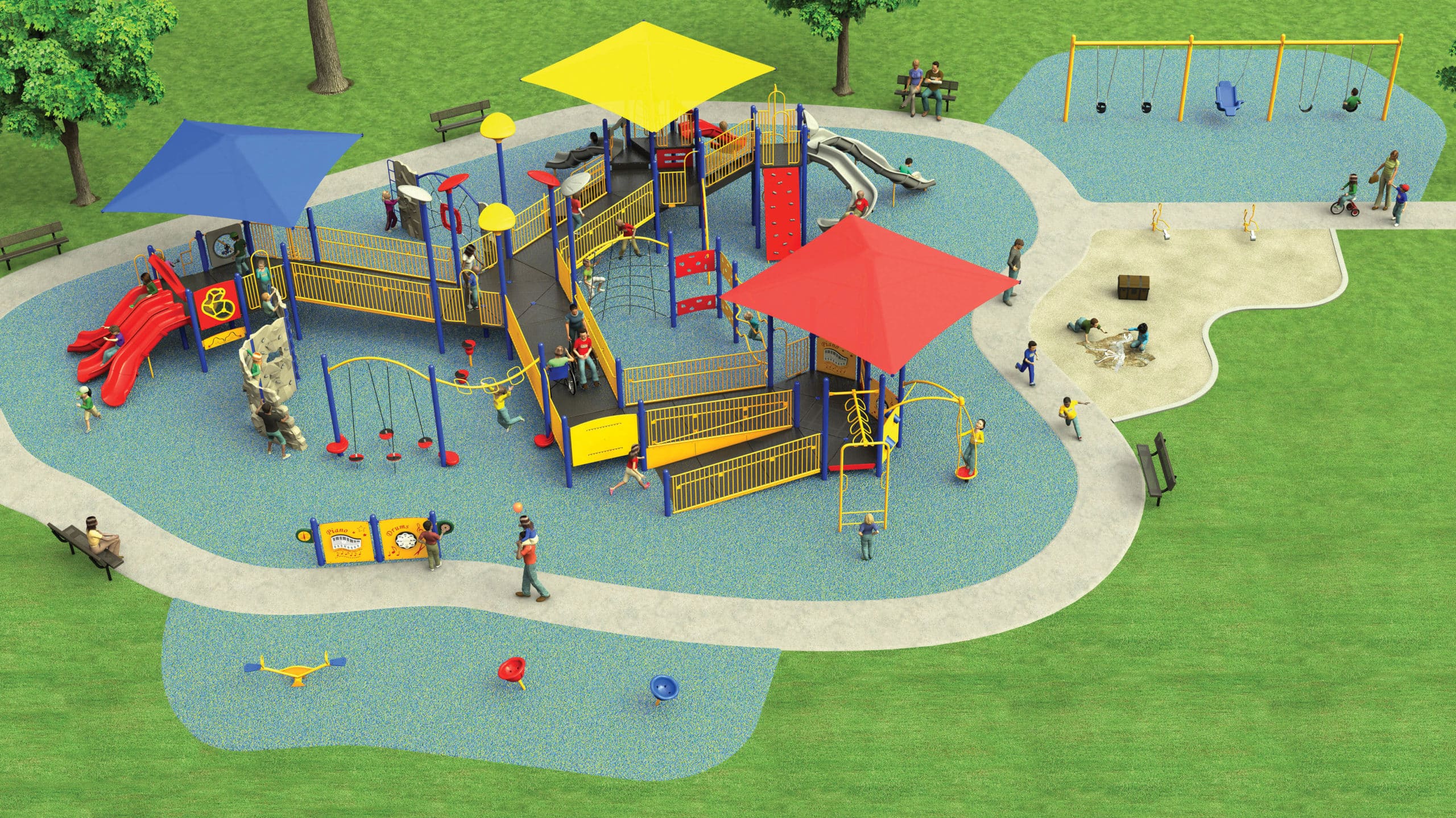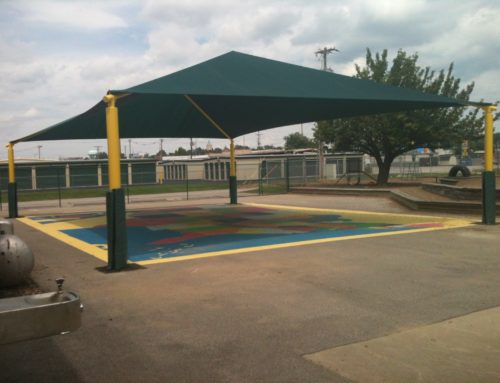The Importance Of Access
The Americans with Disabilities Act of 1990 (ADA) is a wide-ranging civil-rights law prohibiting, under certain circumstances, discrimination based on disability, which is defined by the ADA as “a physical or mental impairment that substantially limits a major life activity.”
The ADA establishes standards by which public facilities, including public play spaces, must comply to ensure opportunities for people of all abilities.
Complying with ADA standards is the law, but it’s also advantageous to the mission of encouraging more free play for kids.
Free play on playgrounds has been scientifically proven to have a variety of physical, mental, emotional, and cognitive benefits for children and parents of all ages, and can be an important activity to promote family interaction and relationship-building.
Making sure a public play space is accessible to all–not only for children of varying abilities, but for parents, grandparents, and caregivers with different physical conditions–helps ensure a play space that is a healthy community gathering spot.
Playground equipment and surfacing materials are both subject to ADA standards. Specific guidelines for play components–both ground and elevated–and surfacing materials and access routes are listed below.
But having compliant materials and designs isn’t enough. Vigilance with regard to proper installation and maintenance procedures is the key to upholding compliance. Working with certified experts on installation and maintenance is recommended to safeguard the investment made in a compliant facility.
Understanding The Standards
Because there can be some confusion about the standards for new or existing public play facilities, the International Play Equipment Manufacturers Association (IPEMA)–the industry’s membership association that provides third-party validation and certification for playground equipment and surfacing safety standards–has compiled a toolkit designed to help those in charge of play facilities with compliance.
The Checklist for Access summarizes 12 key steps for compliance. It is intended to help owners of public play areas understand how to use the Department of Justice’s 2010 Standards for Accessible Design.
Newly constructed and altered play areas must comply with the 2010 Standards for Accessible Design (includes the play-area guidelines) on or after March 15, 2012.
Requirements And Key Considerations For Existing Playgrounds
Existing play areas are not required to meet the 2010 Standards by March 15, 2012.
March 15, 2012, is the Department of Justice’s compliance date for all entities covered by Title II, and Title III must begin using the new (2010) accessibility standards. This means all new construction and alterations to existing facilities should begin utilizing these standards.
It is important to understand that playgrounds built prior to March 15, 2012, are subject to review if they are undergoing alteration, or if physical or communication barriers exist to the programs, goods, services, or activities offered at the facility.
The new Department of Justice’s 2010 Standards for Accessible Design trigger access if one is building a new playground or making an alteration to an existing playground. In both cases, owners need to provide a primary means of access.
Here is the “real” consideration: If there is an existing playground and no alterations are planned, the question becomes “Are there any barriers to participation by people with disabilities?”
Can a person with a disability gain entry into the playground by an accessible route?
Providers of public playgrounds have the responsibility under the Program Access standard to remove barriers and make their programs, services, and activities accessible. So if the facility doesn’t currently provide access, barriers should be identified in an official transition plan. This should include a prioritized action plan for accessibility improvements.
One of the most important playground-access activities is to complete an audit of the facilities and create a realistic transition plan to remove all physical and communication barriers to programs, services, and activities for people with disabilities.
Public Playground Accessibility Checklist
1. Public playgrounds must have an accessible route at least 60 inches wide, a maximum running slope of 1:20, and a maximum cross slope of 1:50. The route to the play area is an accessible route. Minimum width is 36 inches, and the maximum slope is 1:12. Any running slope over 1:20 or 5 percent is treated as a ramp with handrails and landings.
2. Within the play area, the safety surfacing must comply with ASTM F 1292-99 or -04 Standard Specification for Impact Attenuation of Surface Systems Under and Around Playground Equipment when located within the use zone for proper impact attenuation. All accessible routes within the play area, clear floor, or ground spaces at play components required to be accessible and turning spaces must comply with ASTM 1951-99 Standard Specification for Determination of Accessibility of Surface Systems Under and Around Playground Equipment.
3. Within the play area, the accessible route must be at least 60 inches wide, with a maximum running slope of 1:16, a maximum cross slope of 1:48, and a minimum of 80 inches overhead clearance. For small play areas of less than 1,000 square feet in total size, the accessible route must be at least 44 inches wide, with a maximum running slope of 1:16, a maximum cross slope of 1:48, and a minimum of 80 inches overhead clearance.
4. Composite play structures that include a transfer system as a means of access must meet the following criteria:
• Transfer platform height must be between 11 and 18 inches with a clear minimum width of 24 inches and a depth of 14 inches
• Transfer steps are a maximum of 8 inches high, and include handholds to aid movement.
• Minimum 30-inch by 48-inch transfer space must be provided adjacent to the transfer platform. The 48-inch-long minimum dimension of the transfer space shall be centered on and parallel to the 24-inch-long minimum side of the transfer platform. The side of the transfer platform serving the transfer space shall be unobstructed.
5. Composite play structures that include ramps connecting elevated play components as a means of access must meet the following criteria:
• Elevated ramps must be at least 36 inches wide, with a maximum running slope of 1:12, and a maximum length of 144 inches (12 feet) before providing a landing.
• Elevated ramps must include handrails on both sides, meeting hand-gripping criteria, and with a height between 20 and 28 inches. Elevated ramps with handrails, barriers beyond the ramp edge, and barriers not extending within 1 inch of the ramp surface must have edge-curbing at least 2 inches high for the entire ramp length. No handrail extensions are required.
• When elevated ramps change in direction, a 60-inch by 60-inch minimum level landing must be provided at both the top and the bottom of each run.
6. Elevated ramps and accessible platforms attached at ramp levels shall have no openings on a surface greater than ½ inch, and a vertical change in level less than ¼ inch or up to ½ inch with a 2:1 beveled edge.
7. Openings on elevated-ramp accessible platforms for access/egress play opportunities must be narrowed to 15 inches or less.
8. Advisory reach-ranges for accessible manipulative and interactive sensory and communicative components must have reach-range heights between 18 and 44 inches for the 5- to 12-year-old user group and between 20 and 36 inches for the 2- to 5-year-old user group.
9. Ground-level upper-body equipment intended for use by a person using a mobility device must be less than 48 inches above protective surfacing.
10. Ground-level play tables and components must have a minimum vertical-knee clearance of at least 24 inches high, a minimum depth of at least 17 inches, and a minimum width of at least 30 inches. The maximum top of a playing surface shall not exceed 31 inches.
11. Composite play structures must have elevated accessible routes by ramp and/or transfer systems to connect at least 50 percent of the elevated play components. Large composite play structures with more than 20 elevated play components must have at least 25 percent of the elevated play components connected by elevated ramps.
12. Play areas must have the minimum number of accessible play components and types on the accessible routes per the following criteria: One of each type at ground level and 50 percent elevated must be accessible. The trigger to use the table is for additional numbers and types. Where elevated play components are provided, ground-level play components shall be provided in accordance with Table 240.2.1.2, and shall comply with 1008.4. EXCEPTION: If at least 50 percent of the elevated play components are connected by a ramp and at least three of the elevated play components connected by the ramp are different types of play components, the play area shall not be required to comply with F240.2.1.2.
Confused? Play It Safe Playgrounds and Park Equipment, Inc. offers free consultation. If you need a little guidance about the ADA standards on your new or existing playground, gives us a call…we’ll figure it out together!





